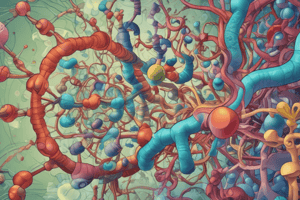Podcast
Questions and Answers
What is keratan?
What is keratan?
- A type of protein
- A type of lipid
- A mucopolysaccharide (correct)
- A type of nucleic acid
What is the main function of glycosaminoglycans (GAGs)?
What is the main function of glycosaminoglycans (GAGs)?
- To regulate gene expression
- To act as a lubricant and cushion for tissues (correct)
- To synthesize proteins
- To provide structural support to cells
What is the property of glycosaminoglycans (GAGs) that allows them to hold large quantities of water?
What is the property of glycosaminoglycans (GAGs) that allows them to hold large quantities of water?
- Hydrogen bonding
- Electrostatic attraction
- Repulsion of their negative charges (correct)
- Hydrophobic interactions
What is the result of compressing a solution of glycosaminoglycans (GAGs)?
What is the result of compressing a solution of glycosaminoglycans (GAGs)?
What happens to glycosaminoglycans (GAGs) when the compression is released?
What happens to glycosaminoglycans (GAGs) when the compression is released?
What is the cause of resilience of synovial fluid and the vitreous humor of the eye?
What is the cause of resilience of synovial fluid and the vitreous humor of the eye?
What type of molecule is keratan composed of?
What type of molecule is keratan composed of?
What is a characteristic of glycosaminoglycans (GAGs)?
What is a characteristic of glycosaminoglycans (GAGs)?
What is true about keratan?
What is true about keratan?
What is the function of glycosaminoglycans (GAGs) in connective tissue?
What is the function of glycosaminoglycans (GAGs) in connective tissue?
Study Notes
Carbohydrates
- Carbohydrates are classified into simple and compound carbohydrates.
- Simple carbohydrates include monosaccharides, which are the building blocks of carbohydrates.
- Compound carbohydrates are formed by the condensation of two or more monosaccharides.
Monosaccharides Derivatives
- Sugar derivatives are formed by modifying monosaccharides through oxidation, reduction, or replacement of hydroxyl groups.
- Types of sugar derivatives include:
- Sugar acids (e.g. aldonic acids, uronic acids, aldonic acids)
- Sugar alcohols (e.g. sorbitol, mannitol)
- Amino sugars (e.g. replacement of hydroxyl group with an amino group)
- Deoxy sugars (e.g. replacement of hydroxyl group with a hydrogen atom)
Disaccharides
- Disaccharides are formed by the condensation of two monosaccharides.
- The general formula for disaccharides is Cn(H2O)n-1.
- Examples of disaccharides include:
- Maltose (2 α-glucose molecules linked by α1-4 glycosidic bond)
- Isomaltose (2 α-glucose molecules linked by α1-6 glycosidic bond)
- Cellobiose (2 β-glucose molecules linked by β1-4 glycosidic bond)
- Lactose (β-glucose + β-galactose linked by β1-4 glycosidic bond)
- Sucrose (α-glucose + β-fructose linked by α1-β2 glycosidic bond)
Polysaccharides
- Homopolysaccharides are composed of a single type of monosaccharide.
- Examples of homopolysaccharides include:
- Glycogen (animal starch, stored in liver and muscles)
- Cellulose (structural carbohydrate in plants, found in plant cell walls)
- Heteropolysaccharides are composed of two or more different types of monosaccharides.
- Examples of heteropolysaccharides include:
- Glycosaminoglycans (GAGs) or mucopolysaccharides
- Proteoglycans (chains of GAGs attached to a protein core)
- Glycoproteins (protein core with a short branched chain of carbohydrate)
Glycosaminoglycans (GAGs)
- GAGs are long, unbranched polysaccharides containing a repeating disaccharide unit.
- They are composed of modified sugars, including:
- N-acetylgalactosamine (GalNAc) or N-acetylglucosamine (GlcNAc)
- Uronic acid (e.g. glucuronate or iduronate)
- Sulphate groups
- Examples of GAGs include:
- Hyaluronic acid (found in synovial fluid, vitreous humor of eyes, and loose connective tissue)
- Chondroitin sulphate (found in cartilage and bone)
- Dermatan sulphate (found in sclera of eyes and important for overall shape of eyes)
- Heparin (found in cells and highly acidic, anticoagulant)
- Keratan sulphate (found in proteoglycans and lacks uronic acid)
- GAGs act as a lubricant and cushion in connective tissue, and have the ability to hold large quantities of water due to their negative charges.
Studying That Suits You
Use AI to generate personalized quizzes and flashcards to suit your learning preferences.
Description
This quiz assesses the understanding of carbohydrates, including their structure, classification, functions, and properties. It covers simple and compound carbohydrates, lipids, and amino acids.




